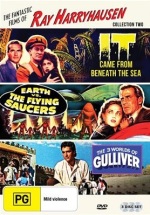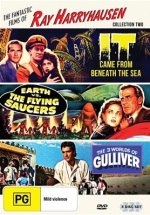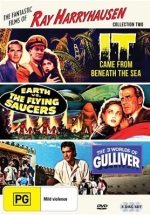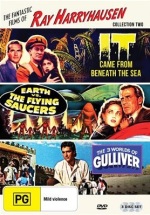Fantastic Films of Ray Harryhausen: CollectionTwo, The (Blu-ray) (2018) |
|
Fantastic Films of Ray Harryhausen: CollectionTwo, The (Blu-ray) (2018) |
|


|
| BUY IT |
Before Star Wars, before Jurassic Park there was special effect guru Ray Harryhausen, whose career spanned decades but whose influence upon filmmakers continues to this day. The Fantastic Films of Ray Harryhausen: Collection Two from ViaVision contains three of his earlier films, a creature feature, a flying saucer attack on Washington and a fantasy adventure in glorious HD with commentaries and extras, and is a wonderful opportunity to watch Harryhausen’s craft develop. The films are classic adventure tales, very entertaining, with special effects that are still impressive.
| Video | |
| Audio | |
| Extras | |
| Plot | |
| Overall |
It Came From Beneath the Sea (Blu-ray) (1955) |
|


|
| BUY IT |
| General | Extras | ||
| Category | Fantasy |
Alternative Version-Colorized version of It Came From Beneath the Sea More…-BD Live Audio Commentary-Ray Harryhausen and visual effects artists Featurette-Remembering It Came from Beneath the Sea (21:44) Featurette-A Present Day Look at Stop Motion (11:38) Featurette-Tim Burton Sits Down with Ray Harryhausen (27:09) Featurette-David Schechter on Film Music’s Unsung Hero (22:33) Featurette-Original Ad Artwork (17:52) More…-”It Came From Beneath the Sea Again” Comic Book Gallery-(29:50) Theatrical Trailer-x 3 |
|
| Rating |

|
||
| Year Of Production | 1955 | ||
| Running Time | 79:07 | ||
| RSDL / Flipper | Dual Layered | Cast & Crew | |
| Start Up | Menu | ||
| Region Coding | 2,4 | Directed By | Robert Gordon |
|
Studio
Distributor |
 ViaVision |
Starring |
Kenneth Tobey Faith Domergue Donald Curtis |
| Case | ? | ||
| RPI | ? | Music | Mischa Bakaleinikoff |
| Video | Audio | ||
| Pan & Scan/Full Frame | None | English Dolby TrueHD 5.1 | |
| Widescreen Aspect Ratio | 1.85:1 | ||
| 16x9 Enhancement |
 |
||
| Video Format | 1080p | ||
| Original Aspect Ratio | 1.85:1 | Miscellaneous | |
| Jacket Pictures | No | ||
| Subtitles |
English English for the Hearing Impaired French Spanish Portuguese Japanese Korean Arabic Hindi |
Smoking | Yes |
| Annoying Product Placement | No | ||
| Action In or After Credits | No | ||
The nuclear submarine of Commander Pete Mathews (Kenneth Tobey) is on its shakedown cruise in the Pacific when it encounters a radioactive “blob” on its sonar that brings the submarine to a stop. After the sub breaks free they find radioactive matter stuck in the diving planes and return to Pearl Harbour for repairs. The navy brings in marine biologists Dr John Carter (Donald Curtis) and Professor Lesley Joyce (Faith Domergue) to examine the organic matter. After a few weeks they believe that it was part of a massive octopus but the navy brass rejects this hypothesis. They change their minds when a tramp steamer is destroyed in the North Pacific and the creature appears on the coast of Oregon heading for San Francisco. Mathews, Carter and Lesley hurry to San Francisco to coordinate the defence of the Bay area and to work out ways to kill the creature.
It Came From Beneath the Sea is one of the myriad of 1950s low budget creature features that resulted from mankind messing with the atom bomb. It was directed for Columbia by Robert Gordon, a journeyman director who worked mostly in TV, but the most important aspect of the picture is that it marked the first collaboration between producer Charles Schneer and special effects stop motion wizard Ray Harryhausen, a partnership that lasted for decades until Clash of the Titans is 1981. The script and acting in It Came From Beneath the Sea are pedestrian; Kenneth Tobey is a familiar face with 220 credits, mostly TV episodes, on his CV but his character’s role here is mostly to be part of a very heavy handed romance subplot; the film also adds in some bits about female empowerment for good measure.
However, the appeal of a special effects creature film is obviously the effects created by Harryhausen. Given the film was made in 1955, these still look very good; Harryhausen had studied the movements of a real octopus but, having to stop motion each tentacle individually, he was careful to only show one or two in each shot as much as possible; indeed, to save money his octopus never had more than 6 tentacles anyway but when watching the film you don’t really notice. Some sequences are still wonderful, such as the sinking of the tramp steamer or the destruction of the Golden Gate Bridge in San Francisco using models; the weakest, or least believable model, is the submarine caught in the tentacles near the climax.
Between effects sequences the film tends to drag, as was the case in a lot of these 1950s low budget B movie creature films, the romance being particularly jarring. However, when the creature and destruction is on screen It Came From Beneath the Sea is a heap of fun.
It Came From Beneath the Sea is presented in the 1.85:1 aspect ratio, in 1080p using the MPEG-4 AVC code.
Both the Black and White and Colourised versions (called Chromachoice on the menu) of It Came From Beneath the Sea are provided on the Blu-ray. You are able to toggle between the versions using the “Angle” button on the remote.
The colours of the colourised version are flat but generally look natural enough with the exception of the fire and flamethrower yellows. It may be sacrilege but I did enjoy the colour version and the sequence of the destruction of the red Golden Gate Bridge is great! Indeed, the colourised version smooths out some of the slight blemishes and grain evident in the black and white print, especially in the back projection shots with live action in the foreground that look soft; but this is 1955 technology after all! Elsewhere, the black and white evinced solid detail, very good blacks and greys. Brightness and contrast is consistent.
Grain is more obvious in the black and white version as were the minor blemishes.
English and English subtitles for the hearing impaired are provided, plus subtitles in French, Spanish, Portuguese, Japanese, Korean, Arabic and Hindi.
| Sharpness | |
| Shadow Detail | |
| Colour | |
| Grain/Pixelization | |
| Film-To-Video Artefacts | |
| Film Artefacts | |
| Overall |
The audio is English Dolby TrueHD 5.1.
The film was released in theatres with mono audio and this track is still front oriented, although it does come alive during creature attacks with the screech of metals and the creature, waves and destruction of buildings. Dialogue is clear. The subwoofer was mostly noticeable during creature attacks, the depth charge and mine explosion scenes.
The music for It Came From Beneath the Sea was provided by Mischa Bakaleinikoff who has a massive 483 credits on the IMDb; he composed the creature theme but most of the score he reused from the Columbia stock library.
There are no lip synchronisation issues.
| Dialogue | |
| Audio Sync | |
| Clicks/Pops/Dropouts | |
| Surround Channel Use | |
| Subwoofer | |
| Overall |
At start-up is an ad for Blu-rays. This is also available from the Trailers menu.
Both the Black and White and Colorized versions of It Came From Beneath the Sea are provided on the Blu-ray; at any time you can use the “Angle” button on the remote to toggle between them.
If the Blu-ray player is connected to the internet, access other material.
Arnold Kunert sits with Ray Harryhausen, animation expert Randy Cook and visual effects artist John Bruno as they watch the colourised version of the film. Kunert controls discussion and asks questions; the group talk about how the project came about, various cast members and their careers, the colours in the colourised version, the size of the octopus model, the number of tentacles, the size of the models as well as the techniques used during various effects shots although as this commentary was being recorded 57 years after the film Harryhausen a number of times says that he does not remember how things were done.
This extra is better than a “remembering” piece. Made in 2007 it mostly features Ray Harryhausen speaking about how It Came from Beneath the Sea came about, meeting his long term producing partner Charles Schneer, researching how an octopus moves and the film’s low budget, but the majority is Harryhausen explaining how he did the special effect stop motion shots, including the destruction of the Golden Gate Bridge, which is fascinating. Some film footage plus minor input from John Bruno, a special effects artist who speaks about the first time he saw the film, and historian John Canemaker.
Also made in 2007, Kyle Anderson, a student at NYU, shows how to design and made the puppets and how to animate them, including lip movements.
Director Tim Burton visits Harryhausen at home and they chat, and play with, some of the models from Earth vs. The Flying Saucers. They talk about Harryhausen’s influences, his characters, working with writers and the budgets of his early Columbia films. Harryhausen says how delighted he is that his three black and white Columbia films are being colourised for if they had the budget at the time they would have been made in colour!
Soundtrack producer David Schechter talks about the techniques of Columbia’s B picture’s unsung hero Mischa Bakaleinikoff who both composed themes, and utilised Columbia’s stock music library, for numerous pictures. He concentrates on the Harryhausen black and white pictures It Came From Beneath the Sea, Earth vs. The Flying Saucers and 20 Million Miles to Earth showing the repeating themes and where library music was reused from other unrelated Columbia films. For example, he points out that music from 18 composers was used by Bakaleinikoff during scoring for 20 Million Miles to Earth.
Producer Arnold Kunert shows and analyses the Press Books, promotional materials and lobby cards of It Came From Beneath the Sea, Earth vs. The Flying Saucers and 20 Million Miles to Earth.
Sixteen screens of the colour comic book; silent, use the remote to advance.
Copious photo galleries of the film’s promotional artwork in various languages, production stills and Ray Harryhausen’s artwork. The photos advance automatically with the film’s soundtrack, dialogue and effects.
The following trailers, plus an ad for Blu-ray, are available: 20 Million Miles To Earth (2:00), Earth vs. The Flying Saucers (2:16) and The 7th Voyage of Sinbad (1:41).
NOTE: To view non-R4 releases, your equipment needs to be multi-zone compatible and usually also NTSC compatible.
Elsewhere It Came From Beneath the Sea is only available on Blu-ray in box sets with other Harryhausen films that differ with each box set. See this link here for some of the sets. There is no direct equivalent to this, Australian released set. We get the black and white and colourised versions, plus all the extras that were available on the Sony Region Free US release. As a box set, ours is fine.
It Came From Beneath the Sea still retains its charm after more than 60 years because of the wonderful stop motion creature work of wizard Ray Harryhausen. One could be nostalgic for a time when things were done practically instead of wall to wall CGI, but these effects, and films, transcend nostalgia because they are still great fun and wonderful entertainment. The colourised version gives a whole different look to the film.
The video and audio are very good for a 60 year old B movie, the extras genuine.
It Came From Beneath the Sea is included in the 3 Blu-ray package from ViaVision The Fantastic Films of Ray Harryhausen: Collection Two which also includes Earth vs. The Flying Saucers (1956) and The 3 Worlds of Gulliver (1960), all with commentaries and other extras, a treat for fans of Harryhausen or classic sci-fi adventure.
| Video | |
| Audio | |
| Extras | |
| Plot | |
| Overall |
| Review Equipment | |
| DVD | Sony BDP-S580, using HDMI output |
| Display | LG 55inch HD LCD. This display device has not been calibrated. This display device is 16x9 capable. This display device has a maximum native resolution of 1080p. |
| Audio Decoder | NAD T737. This audio decoder/receiver has not been calibrated. |
| Amplification | NAD T737 |
| Speakers | Studio Acoustics 5.1 |
Earth vs. the Flying Saucers (Blu-ray) (1956) |
|


|
| BUY IT |
| General | Extras | ||
| Category | Fantasy |
Alternative Version-Black and White and Colorized versions Audio Commentary-Ray Harryhausen and visual effects artists Featurette-The Hollywood Blacklist and Bernard Gordon (29:27) Featurette-Remembering Earth vs. the Flying Saucers (21:25) Interviews-Cast-Joan Taylor (17:29) Featurette-The Colorization Process (11:02) More…-Original Screenplay Credits (3:16) More…-”Flying Saucers vs. The Earth” Comic Book Gallery-Posters and photos Trailer-x 3 for other Harryhausen films |
|
| Rating |

|
||
| Year Of Production | 1956 | ||
| Running Time | 83:43 | ||
| RSDL / Flipper | Dual Layered | Cast & Crew | |
| Start Up | Menu | ||
| Region Coding | 2,4 | Directed By | Fred F Sears |
|
Studio
Distributor |
 ViaVision |
Starring |
Hugh Marlow Joan Taylor Morris Ankrum Donald Curtis |
| Case | ? | ||
| RPI | ? | Music | Mischa Bakaleinikoff |
| Video | Audio | ||
| Pan & Scan/Full Frame | None |
English Dolby TrueHD 5.1 French Dolby Digital 2.0 English Audio Commentary Dolby Digital 2.0 |
|
| Widescreen Aspect Ratio | 1.85:1 | ||
| 16x9 Enhancement |
 |
||
| Video Format | 1080p | ||
| Original Aspect Ratio | 1.85:1 | Miscellaneous | |
| Jacket Pictures | No | ||
| Subtitles |
English English for the Hearing Impaired French Japanese Spanish Portuguese Arabic Hindi |
Smoking | Yes |
| Annoying Product Placement | No | ||
| Action In or After Credits | No | ||
Newlyweds Russell and Carol Marvin (Hugh Marlow, Joan Taylor) are driving on a desert highway when their car is buzzed by a flying saucer. Russell is a scientist, the director of a nearby facility that has been sending communications satellites into space for the US military; they have launched eleven but have been unable to contact any of them since launch. Carol’s father, General John Hanley (Morris Ankrum) arrives at the launch facility; he has examined space debris in Panama and has concluded that it is one of their satellites. Russell decides to go ahead and launch number twelve but just before the launch a flying saucer appears and lands at the facility. The soldiers guarding the site open fire on the saucer, which responds killing the soldiers, destroying the facility and taking away an unconscious General Hanley. Deep in an underground bunker Russell and Carol are the only survivors.
Russell and Carol are taken to Washington to tell what happened but the brass remain sceptical. However, Russell discovers that the aliens have been trying to contact him; against orders he arranges to meet a saucer; Carol and military minder Major Huglin (Donald Curtis) follow Russell and they all go inside the saucer. They discover the fate of General Hanley and are informed that the Earth has 56 days to gather the world’s leaders in Washington or the saucers will attack. The military are determined to resist so Russell and other scientists have 56 days to invent and test a weapon that is capable of defeating the saucers.
Earth vs. the Flying Saucers is the second film producer Charles Schneer and special effects wizard Ray Harryhausen made for Columbia in the 1950s. It was directed by Fred F Sears, a journeyman director; Earth vs. the Flying Saucers is one of six films he made that were released in 1956. The film marks a departure for Harryhausen from his previous stop motion creature features, and although his work here influenced later films, including Mars Attacks! and Independence Day (both 1996), to my mind the inanimate flying saucers lack the “character” of Harryhausen’s creatures such as the giant octopus in It Came From Beneath the Sea; we have sympathy with the creature and sad to see it destroyed, which is not the case with the impersonal saucers. There is also a flat middle section in Earth vs. the Flying Saucers, full of exposition, talk and scientific gobbledegook, but when the attack starts and the saucers destroy iconic Washington buildings and monuments the film is wonderful, and still looks impressive 60 years after being made. Who does not love to see the Capital Building destroyed!
Earth vs. the Flying Saucers is presented in the 1.85:1 aspect ratio, in 1080p using the MPEG-4 AVC code.
Both the Black and White and Colourised versions (called Chromachoice on the menu) of Earth vs. the Flying Saucers are provided on the Blu-ray. You can toggle between the versions using the “Angle” button on the remote.
The colours of the colourised version are flat and don’t look as natural, or as effective, as the colourisation of It Came From Beneath the Sea. It may be that the stock footage that was used extensively in Earth vs. the Flying Saucers did not lend itself to colourisation as easily as the footage shot for the film. Detail in back projection shots with live action in the foreground and saucers behind look soft in either version, but this is 1956 technology! The black and white print showed good, solid detail and excellent blacks and greys. Brightness and contrast is consistent.
Grain is very apparent, especially in stock footage and there are a number of slight marks, some vertical lines and motion blur against banks of instruments.
English and English subtitles for the hearing impaired are provided, plus subtitles in French, Spanish, Portuguese, Japanese, Arabic and Hindi.
| Sharpness | |
| Shadow Detail | |
| Colour | |
| Grain/Pixelization | |
| Film-To-Video Artefacts | |
| Film Artefacts | |
| Overall |
The main audio is English Dolby TrueHD 5.1 and there is a French Dolby Digital 2.0 dub. The audio commentary is Dolby Digital 2.0.
The film was released in theatres with mono audio and this track is front oriented, with mostly music and some effects in the surrounds such as explosions. Dialogue is clear. The subwoofer was mostly noticeable during the crashes and explosions.
The music for Earth vs. the Flying Saucers was provided by an uncredited Mischa Bakaleinikoff,mostly reusing scores from the Columbia stock library.
There are no lip synchronisation issues.
| Dialogue | |
| Audio Sync | |
| Clicks/Pops/Dropouts | |
| Surround Channel Use | |
| Subwoofer | |
| Overall |
At start-up an ad for Blu-ray plays. This is also available from the trailers menu.
Both the Black and White and Colorized versions of Earth vs. the Flying Saucers are provided on the Blu-ray; at any time you can use the “Angle” button on the remote to toggle between them.
If the Blu-ray player is connected to the internet, access other material.
Ray Harryhausen, Arnold Kunert and visual effects artists Jeffrey Okun, Keith Ralston sit together and chat. This is a rather trivial commentary and they joke a fair bit but they do talk about how the film came about, the sound effects, the colourisation, the use of stock footage, the budget, how certain effects were done, locations and the cast.
Made in 2007, Del Reisman of the Writers Guild of America speaks about the reign of the House Un-American Activities Committee and its effects upon American society and Hollywood, including writers who were blacklisted for 15 years. Unlike actors, who were well known to the public, most writers were not known so could work under a false name, producers knowing full well that the writer was blacklisted and thus could not be given a film credit. Reisman was one of a three man committee appointed by the Guild in the late 1980s to investigate, and restore, writer credits. He speaks briefly about the now restored credit for Bernard Gordon on Earth vs. the Flying Saucers and points out other anomalies, such as a screenplay Academy Award given to a man who did not write the picture, the real writer being blacklisted, and he also talks about restoring the writers’ credits for Carl Foreman and Michael Wilson on Bridge on the River Kwai. Fascinating.
Made in 2007 this features Ray Harryhausen playing with his flying saucer models from the film and speaking about how Earth vs. the Flying Saucers came about, researching UFO sightings, giving the flying saucers a character and how they did the stop motion destruction of the Washington buildings and monuments. He then talks about how his stop motion films inspired filmmakers, including George Lucas and Steven Spielberg an influence confirmed by interviews with special effects man Stan Winston and directors Frank Darabont and Terry Gilliam. Additional comments by historian John Canemaker.
A lively and spritely Taylor talks about her background, how she got into movies including westerns and the 1954 MGM musical Rose Marie, comments about her co-stars, her memories of Earth vs. the Flying Saucers and 20 Million Miles To Earth and her subsequent career in TV.
This is a bit of a disappointment. Harryhausen and Legend Films (who did the colourisation) people Barry Sandrew, David G Martin and Rosemary Horvath mostly talk about how wonderful the colourisation process is and how it is a good idea. There is very little about the actual process itself; any examples are from 20 Million Miles To Earth.
The original credit sequence showing Raymond T Marcus as the co-writer instead of blacklisted co-writer Bernard Gordon.
Fifteen screens of the colour comic book; silent, use the remote to advance.
Copious photo galleries of the film’s promotional artwork in various languages and production stills. The photos advance automatically with the film’s soundtrack, dialogue and effects.
The following trailers, plus an ad for Blu-ray, are available: 20 Million Miles To Earth (2:00), It Came From Beneath the Sea (2:03) and The 7th Voyage of Sinbad (1:41).
NOTE: To view non-R4 releases, your equipment needs to be multi-zone compatible and usually also NTSC compatible.
Elsewhere Earth vs. the Flying Saucers is only available on Blu-ray in a box set with other Harryhausen films. See the link here for some of the sets. There is no direct equivalent to this, Australian released set. We get the black and white and colourised versions, plus most of the extras that were available on the Sony Region Free US release. What is not on this film is on the It Came From Beneath the Sea film that is included in our box set. As a box set, ours is fine.
I don’t think that Earth vs. the Flying Saucers is a top level Ray Harryhausen effort; the inanimate saucers lack the character of his best creatures but the film certainly influenced later filmmakers and the destruction of Washington buildings and monuments is always a hoot. The colourised version is a bonus.
The video and audio are very good for a 60 year old B movie, the extras genuine and interesting.
Earth vs. the Flying Saucers is included in the 3 Blu-ray package from ViaVision The Fantastic Films of Ray Harryhausen: Collection Two which also includes It Came From Beneath the Sea (1955) and The 3 Worlds of Gulliver (1960), all with commentaries and other extras, a treat for fans of Harryhausen or classic sci-fi adventure.
| Video | |
| Audio | |
| Extras | |
| Plot | |
| Overall |
| Review Equipment | |
| DVD | Sony BDP-S580, using HDMI output |
| Display | LG 55inch HD LCD. This display device has not been calibrated. This display device is 16x9 capable. This display device has a maximum native resolution of 1080p. |
| Audio Decoder | NAD T737. This audio decoder/receiver has not been calibrated. |
| Amplification | NAD T737 |
| Speakers | Studio Acoustics 5.1 |
3 Worlds of Gulliver, The (Blu-ray) (1960) |
|


|
| BUY IT |
| General | Extras | ||
| Category | Adventure |
Audio Commentary-Film historians Randall Cook, Courtney Joyner,Stephen Smith Featurette-The Making of The 3 Worlds of Gulliver (7:32) Featurette-The Harryhausen Chronicles (57:57) Featurette-This is Dynamation (11:02) Theatrical Trailer |
|
| Rating |

|
||
| Year Of Production | 1960 | ||
| Running Time | 98:38 | ||
| RSDL / Flipper | Dual Layered | Cast & Crew | |
| Start Up | Menu | ||
| Region Coding | 2,4 | Directed By | Jack Sher |
|
Studio
Distributor |
ViaVision | Starring |
Kerwin Matthews June Thorburn Jo Morrow Lee Patterson Basil Sydney Sherri Alberoni Gregoire Aslan Charles Lloyd Pack |
| Case | ? | ||
| RPI | ? | Music | Bernard Herrmann |
| Video | Audio | ||
| Pan & Scan/Full Frame | None |
English DTS HD Master Audio 2.0 English Audio Commentary DTS HD Master Audio 2.0 |
|
| Widescreen Aspect Ratio | 1.66:1 | ||
| 16x9 Enhancement |
 |
||
| Video Format | 1080p | ||
| Original Aspect Ratio | 1.66:1 | Miscellaneous | |
| Jacket Pictures | No | ||
| Subtitles | None | Smoking | No |
| Annoying Product Placement | No | ||
| Action In or After Credits | No | ||
England 1699: Lemuel Gulliver (Kerwin Matthews) is a poor doctor, struggling to make ends meet so that he can marry his fiancée Elizabeth (June Thorburn). Over Elizabeth’s opposition he signs on as a ship’s doctor on a trading voyage; Elizabeth stows away on board but in a storm Gulliver is swept overboard. He is washed up on the island of Lilliput where the people are only about 5 inches tall where he is discovered by Gwendolyn (Jo Morrow) and Reldresal (Lee Patterson). Gulliver is initially treated with hostility by the tiny people but he soon proves useful to the vain and petty Emperor (Basil Sydney). Indeed, the Lilliputians are at war with their equally tiny neighbours on the nearby island of Blefuscu and the Emperor demands that Gulliver massacre them; Gulliver instead steals the Blefuscidian fleet but the Emperor will not be appeased and orders Gulliver killed. Gulliver escapes in a boat with the help of Reldresal and Gwendolyn; after drifting a while he washes up on the shores of Brobdingnag.
On Brobdingnag it is Gulliver who is tiny as the inhabitants are 60 feet tall. Gulliver is found by a young girl Glumdalchitch (Sherri Alberoni) and taken to the King (Gregoire Aslan). Gulliver discovers that Elizabeth is already there; the King has built them a tiny house and supplies food and clothing and appoints Glumdalchitch to look after them. Things look rosy, but Brobdingnag is a backward and ignorant place, favouring superstition over science and knowledge and Gulliver soon makes an enemy of the King’s alchemist Makovan (Charles Lloyd Pack); Gulliver and Elizabeth are to be executed but are saved, and set adrift, by Glumdalchitch, returning safely to England.
The 3 Worlds of Gulliver is, of course, adapted from part of the satirical novel by Jonathan Swift that was first published in 1726. Many of the foibles and values of the society targeted by Swift almost three centuries ago, greed, pomposity, self-interest, selfishness, pettiness, ignorance, superstition, bickering over trifles and resort to violence rather than science or reason, are very pertinent in today’s societies which is probably why the story of Gulliver’s Travels continues to be known and appreciated today. This is one reason why The 3 Worlds of Gulliver, made in 1960, is worth watching; the greater reason, however, is the amazing special effects of Ray Harryhausen.
It is clear that the popularity of Harryhausen’s earlier films for Columbia resulted in an improved budget for The 3 Worlds of Gulliver; the sets, costumes, number of extras and of course the special effects are wonderful. In The 3 Worlds of Gulliver Harryhausen used mainly travelling and static matte paintings, forced perspective, miniatures and live action to show the interaction between Gulliver and those around him, both tiny and huge. Some stop motion animation (“Dynamation”) is still present and one sequence in particular where Gulliver fights an animated crocodile while the massive Brobdingnagians look on, all within the frame, is fabulous. Indeed, given that this is an era before CGI, the special effects of The 3 Worlds of Gulliver still look wonderful and have a depth and reality that CGI just doesn’t match.
In keeping with the tone of the film, the acting of pretty much all the cast is very broad indeed. Leading man Kerwin Matthews had had practice acting against nothing when he played Sinbad in Harryhausen’s The 7th Voyage of Sinbad (1958) a couple of years earlier; he is a likeable and pleasant personality and as Gulliver helps to anchor The 3 Worlds of Gulliver into some sort of alternate “reality”. Another plus is the score by Bernard Herrmann. He had scored Citizen Kane (1941) and won his only Oscar that same year for All That Money Can Buy but is perhaps now best remembered for his scores for Hitchcock including Vertigo (1958), North By Northwest (1959) and Psycho (1960). For The 3 Worlds of Gulliver he provides a varied score that enhances the viewing experience.
However, naturally, the principal attraction of The 3 Worlds of Gulliver is the wonderful special effects of Harryhausen, which are still impressive.
The 3 Worlds of Gulliver is presented in the 1.66:1 aspect ratio, in 1080p, MPEG-4 AVC.
The 3 Worlds of Gulliver, shot on film, looks glorious. Colours are deep and vibrant, the blue skies and seas, yellow sands, the opulent sets and colourful costumes are all beautiful. Given the film’s combination of forced perspective, stop motion animation, matte paintings, miniatures and live action the detail, including backgrounds, is surprisingly strong with only some softness in occasional sequences. Blacks and shadow detail are great, skin tones, especially Gulliver in some sequences, on the tanned side, brightness and contrast consistent.
There are some tiny small marks plus minor motion blur with movement. Some scenes against the sky are quite grainy but grain is generally controlled and looks pleasant.
There are no subtitles.
| Sharpness | |
| Shadow Detail | |
| Colour | |
| Grain/Pixelization | |
| Film-To-Video Artefacts | |
| Film Artefacts | |
| Overall |
The audio is English DTS-HD MA 2.0 mono. The audio commentary is the same.
Dialogue was clear and easy to understand, even Gulliver’s deep manipulated voice among the Lilliputians. Effects such as the storm at sea, the shooting of arrows, the snapping of the crocodile have a nice feel. The score by Bernard Herrmann, varied and playful, is delivered cleanly. There was obviously no surround or sub-woofer use.
There was no hiss or pops.
There were no lip synchronisation errors.
| Dialogue | |
| Audio Sync | |
| Clicks/Pops/Dropouts | |
| Surround Channel Use | |
| Subwoofer | |
| Overall |
This is a wonderful commentary by Randall Cook (who has three joint Oscars for the Lord of the Rings films), C Courtney Joyner and Stephen C Smith, author of a book on Bernard Hermann. They are great together and full of information as they talk non-stop about the score and the film’s songs, the genesis of the film, identify the cast and outline their careers, the director and cinematographer, how the effects were done, Swift and the source novel, anecdotes about the filming and Harryhausen, merchandising and a whole lot more. Great stuff.
Ray Harryhausen, supported by film footage, black and white photographs and storyboards, speaks about the travelling matte and forced perspective photography used in The 3 Worlds of Gulliver, filming in Spain, the miniatures and storyboards. The final 2 minutes of this extra is a silent slideshow of promotional artwork, storyboards and black and white behind the scenes photographs.
Narrated by Leonard Nimoy and made in 1997, this featurette is an extended interview with Harryhausen as he talks about his career and his craft accompanied by his drawings, some unreleased early stop motion animation and sequences from a number of his films. There are also comments about Harryhausen and his legacy from author and friend Ray Bradbury, producer Charles Schneer, director Henry Selick, Lucasfilm SFX supervisor Dennis Muren and George Lucas himself. This is a wonderful featurette and Ray Harryhausen is a delightful speaker, funny and self-deprecating. It has also been included on other DVD / BD releases, including Jason and the Argonauts and Mysterious Island, but if you have not seen this featurette (or even like me if you have seen it before) it is a must for anyone interested in special effects.
A look at the dynamation process and how it was done, showing examples from Harryhausen’s films. The same featurette has been included on other Harryhausen DVD / BD releases, such as Sinbad and the Eye of the Tiger, The 7th Voyage of Sinbad and Mysterious Island but is worth a look if you have not seen it.
NOTE: To view non-R4 releases, your equipment needs to be multi-zone compatible and usually also NTSC compatible.
The 3 Worlds of Gulliver has had releases with various extras and in various combinations; the US Region free version includes an isolated music score, for example. Included here in The Fantastic Films of Ray Harryhausen: Collection Two with two other films it looks good value.
Swift’s satire on human foibles is still present in The 3 Worlds of Gulliver but the incidents are treated lightly and so The 3 Worlds of Gulliver becomes a rousing fantasy adventure with wondrous special effects. Indeed, it is a film in which almost every frame contains some sort of special effect or other, often more than one. It must have amazed viewers in 1960, and, even in these days of excessive CGI, it is still very impressive. And a heap of fun.
The video and audio are very good, the extras good, although they have mostly already been available on other releases of Harryhausen films.
The 3 Worlds of Gulliver is included in the 3 Blu-ray package from ViaVision The Fantastic Films of Ray Harryhausen: Collection Two which also includes It Came From Beneath the Sea (1955) and Earth vs. the Flying Saucers (1956), all with commentaries and other extras, a treat for fans of Harryhausen or classic adventure.
| Video | |
| Audio | |
| Extras | |
| Plot | |
| Overall |
| Review Equipment | |
| DVD | Sony BDP-S580, using HDMI output |
| Display | LG 55inch HD LCD. This display device has not been calibrated. This display device is 16x9 capable. This display device has a maximum native resolution of 1080p. |
| Audio Decoder | NAD T737. This audio decoder/receiver has not been calibrated. |
| Amplification | NAD T737 |
| Speakers | Studio Acoustics 5.1 |